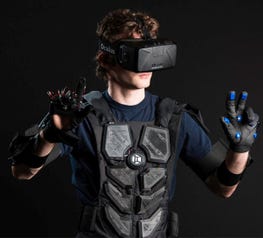A Case for VRMMOs - Design Considerations and the Future for VR Online Multiplayer
Massively Multiplayer Online games are a perfect fit for Virtual Reality, so when will we see them, and what's holding them back?

Virtual Reality and Online Multiplayer I'm sure you all already know what Virtual Reality (VR) is, and you probably know what Massively Multiplayer Online (MMO) games, or Massively Multiplayer Online Roleplaying Games (MMORPGs) are. Though the two technically have different definitions, I will be using MMO and MMORPG interchangeably is this article – mostly for convenience, and also because all MMORPGs are MMOs, and most MMOs are also MMORPGs. The difference really comes from whether one plays as a fictional character in a fantasy-type world or not, though that is quite a lax definition. So why do we want a VR MMO? In MMOs, you take on the persona of a character and play within that world. Even if that character is supposed to be a representation of yourself. People get invested in it to different degrees, but the goal is usually a level of immersion. And what is synonymous with immersion? If this is the kind of article you follow, you'll know that the word "immersion" always goes hand in hand with Virtual Reality. So it certainly appears to be a natural conclusion.
I'm sure you all already know what Virtual Reality (VR) is, and you probably know what Massively Multiplayer Online (MMO) games, or Massively Multiplayer Online Roleplaying Games (MMORPGs) are. Though the two technically have different definitions, I will be using MMO and MMORPG interchangeably is this article – mostly for convenience, and also because all MMORPGs are MMOs, and most MMOs are also MMORPGs. The difference really comes from whether one plays as a fictional character in a fantasy-type world or not, though that is quite a lax definition. So why do we want a VR MMO? In MMOs, you take on the persona of a character and play within that world. Even if that character is supposed to be a representation of yourself. People get invested in it to different degrees, but the goal is usually a level of immersion. And what is synonymous with immersion? If this is the kind of article you follow, you'll know that the word "immersion" always goes hand in hand with Virtual Reality. So it certainly appears to be a natural conclusion.
MMOs are the genre that offer the best possible avenue for virtual reality gaming - to embody the common goal of games to escape from the real world, to remove yourself and enjoy something simpler, and just have fun. If you could not just sit in front of a TV screen, but practically be teleported into a fantasy world, would that not be the ultimate escape? I would argue that with this, VR fulfills the purpose of a game more fully than any other medium before it. But it also depends on the genre of game; current VR games are often demos, many cockpit games, shooting, bows and errows, physics simulations - but those are all things that only facilitate short playtimes, limited freedom, and singleplayer experiences. An MMO would change all of that. Indeed, the reason that we have movies like The Matrix, or the Holodeck in Star Trek, and all these things depicting how one who can control the virtual would can do anything they want, is a refelction of humanity's desire for this kind of technology - this kind of freedom and possibility. And the game genre that fits this best, is an MMORPG. Multiplayer, so you can socialize, go on missions together, make friends, trade items, etc. And an MMO role-playing game because they tend to offer the most flexibility - if you want to fight monsters, you can do that. But at the same time, if you want to focus on your cooking skill, that is also possible. It's that freedom that makes an MMO such a tantalizing proposition for VR. Indeed our lives and whole world could be describes as an MMORPG - oops, I'm venturing back to Matrix territory here. But the point is, MMOs and virtual reality are match made in heaven. So where is my Sword Art Online?? (Sword Art Online – an anime about a matrix-style virtual world game, to explain it briefly to those not familiar.)
Current status of VRMMOs - Where are they?
There are a number of reasons why there are no big VRMMOs yet. The first one, and the most encouraging, is time. Time is indeed the main reason - the current wave of VR is so recent, even if developers had started creating a game when the Oculus Rift first became sucessful, they'd still be working on it now. So we'll have to wait a bit longer before we can start getting jumpy.
The second restriction is the depth required for such a game. MMOs regularly require a lot of depth, from assets like models, textures, and the game world, to things like plot, items, abilities, character customization, quests, etc. And on top of all this, it now has to look and work good still in VR - and that often means better models and textures, less visual shortcuts, more item/environment interactability, and others. This is a lot to tackle for an indie studio, and the big companies aren't setting foot in the market quite yet, to dedicate this many resources to something that, again, is so new.
And compounding on all of this is of course, the networking challanges. A Massively Multiplayer Online game is, naturally, multiplayer. And that means gameplay over the internet, which brings with it the usual connection and networking challanges. And as with everything, it's more demanding in VR. You need a much higher framerate, and most importantly, you need an imperceptibly low amount of lag. Lag in VR, for those who haven't had the stomach-turning pleasure of being strapped into a demo for the Dev Kit 1 of the Oculus running on a computer not nearly powerful enough for it, is a sickening experience that induces nausea and headaches in most people. So, quite an important thing to avoid. And having a game with thousands of people connected, from anywhere in the world, with excellent graphics and more data being sent ofver the network than for usual MMOs, with basically zero lag, is a very, VERY large ask. Hopefully time, again, will solve these problems - global network speeds increasing as internet infastructure is updated, and hacky solutions for dealing with existing network lag in a way to compensate for it in VR, like predictive algorithms, are discovered.
And the final reason that I'm not hacking away at virtual monsters and joining adventure guilds in my living room is that, the market simply isn't there yet. Not enough people have or can afford the hardware required for a Virtual Reality setup. Those that are interested in it and have the money, still may not have the physical space to dedicate to it - especially when we come to room-scale VR. Over time, the price will come down. And VR gaming centers are popping around the world, slowly. This issue as well will, I believe, be solved - but again it comes down to the fact that it currently isn't, and so, VRMMOs right now face a lot of barriers.
But if you're like me, then you'll be delighted to hear that despite the challenges, people are attempting to make VRMMOs. Here are three examples that I was able to find.
-XVIRENT, a game in Kickstarter crowdfunding at the time of writing that is aiming high and focusing on user-generated content to provide depth to the world.
-Voxelnauts, a Minecraft-based game where you explore people’s created worlds together.
-Tridef 3D, not really a game, but a program that creates VR support for The Elder Scrolls: Online. Many other programs like this exist.
We wish these brave pioneers luck, should their success lead to what can be considered the ultimate gaming experience - a virtual reality MMO.
Design Considerations
With the new medium of games that VR is, there are naturally going to be design considerations that have to be made and discovered. Everything from user interfaces(UI) to interaction must be considered. And often, you don't realize something is important until you try to do it in VR, and then realize it isn't well accessible.
If you've ever played one, you'll prabably know that MMOs usually rely heavily on clunky, crowded UIs.

An example of an incredibly crowded UI
With VR, that’s not an option. You can't just slap information in the user's face at the edges of their periphery - it's hard to see and focus on, irritating, hard to read, and even claustrophobic to some.
We can look to media and fiction for inspiration here. A good example was provided by the anime Sword Art Online (SAO). However you feel about it (Personally I think it gets more hate than it should, but that's just me), it's undeniable that we can take lessons from its depiction of a VR environment. For example, a tactile menu that hovers in front of the player is a great way to provide UI information.

An example of the UI seen in anime Sword Art Online
There is some debate on whether SAO's UI is designed well, but there are definately many aspects about it that are nice. For example, it is very minimalistic, not requiring the user to look at blocks of text, or hundreds of options on one screen. The design is simple and not "noisy" or distracting. Current "pages" , "tabs", or dialouge boxes are brought into the foreground, while leaving the ones they came from behind as a trail that can be swiftly navigated back through if necessary.
Now aside from the information that can be nicely organized into an in-game user interface, many other UI elements can be abstracted out to the physical things they represent. For example, if you have a sword as your secondary weapon, you don't need a UI element for that; you can just render a sword at the user's waist. Many things like this can be brought out of a UI and into the game world.
Now for interaction and harware: this is a consideration particularly unique to VR: What range of peripherals will your VRMMO have? Along with from head rotational tracking, the options are many and varied: - Head positional tracking?
- Head positional tracking?
- Hand tracking?
- Full-body tracking?
- Eye tracking?
- Feedback – force feedback? Haptic vests?

An example of a multiple peripherals in use,
(The FOVE, an up-and-coming VR including a haptic vest
headset with built-in eye tracking)
And it's not just the developer of one game that has to make a decision - standards will need to be set before any big MMO comes out. If everyone has all different hardware, then only a small subset of the market will have everything needed to play. And if you decide to make the other peripherals optional, then that almost guarantees a bad time with them - if they're optional, they'll feel like a gimmick: not properly fleshed out, underutilized (because the players without them can't be allowed to feel at a disadvantage), and unneccessary. The safest option at the moment, with the three leaders in the VR field, HTC Vive, Oculus Rift, and Playstation VR, all offering the same things, is a combo of head rotational and positional tracking, and hand tracking. Which is all well and good, but everyone can feel that having only that much is only touching the tip of the iceberg on the kind of experience VR can offer.
Technological restrictions
Basically, Virtual MMOs will really only start to be viable when a better VR solution comes out – something, ideally, with resistive feedback. Resistive feedback is the effect of pushing on a virtual object, and not having your real-life hand go right through it. Something that allows you to feel the force exerted upon you by objects in the virtual world, forces that resist your attempts to move things. Just a vibrating controller doesn't cut it. Yosuke Futami, producer of both seasons of the SAO anime, the film, and who also helped with development of the 3 SAO games, cited the lack of resistive feedback as the biggest reason they could not make a VR SAO game; ”With today’s VR devices, if you cut at your opponent, there would be no accompanying physical sensation. That’s the biggest drawback.”
Now the silver lining to get from that quote is that if VR progresses to that point, we may be able to look forward to being trapped in a virtual reality deathgame yet! But Mr. Futami raises a good point. There are a couple ways to have resistive feedback - the company Dexta Robotics is working on a product called DexMo, which is a hand motion capture platform but it is also able to pull on your fingertips with motors, allowing you to "feel" virtual objects. Extrapolating this idea out into a full exoskeleton is probably the most technologically viable way to achieve full resistive feedback, but that has its own problems, like how expecnsive and hard to manufacture it would be.
In summary - What can we expect for the future? In order for a VRMMO to become a reality, three main things are needed. Firstly, the price of hardware has to come down. This is something that will happen overtime as advancements are made and new products come out. Secondly, the popularity of VR has to rise. You can even help with this! Tell people about VR, show them these articles, and give the makers of VR hardware and software some love. And finally, we'll need improved tech and the setting of standards for VR games.
In order for a VRMMO to become a reality, three main things are needed. Firstly, the price of hardware has to come down. This is something that will happen overtime as advancements are made and new products come out. Secondly, the popularity of VR has to rise. You can even help with this! Tell people about VR, show them these articles, and give the makers of VR hardware and software some love. And finally, we'll need improved tech and the setting of standards for VR games.
So what can we expect? Well, it’s up in the air. There are dissenting voices that say that VR will fail again, and pick up in another 10 years. But the majority of voices and studies seem to be indicating that prices can be expected to drop in the next 5 years, the tech can be expected to improve within the next 5-15 years, and the popularity will only go up from here. In the end, we can’t know for sure. But I for one believe that as long as VR succeeds, MMOs won’t be far behind.
Read more about:
BlogsAbout the Author(s)
You May Also Like













